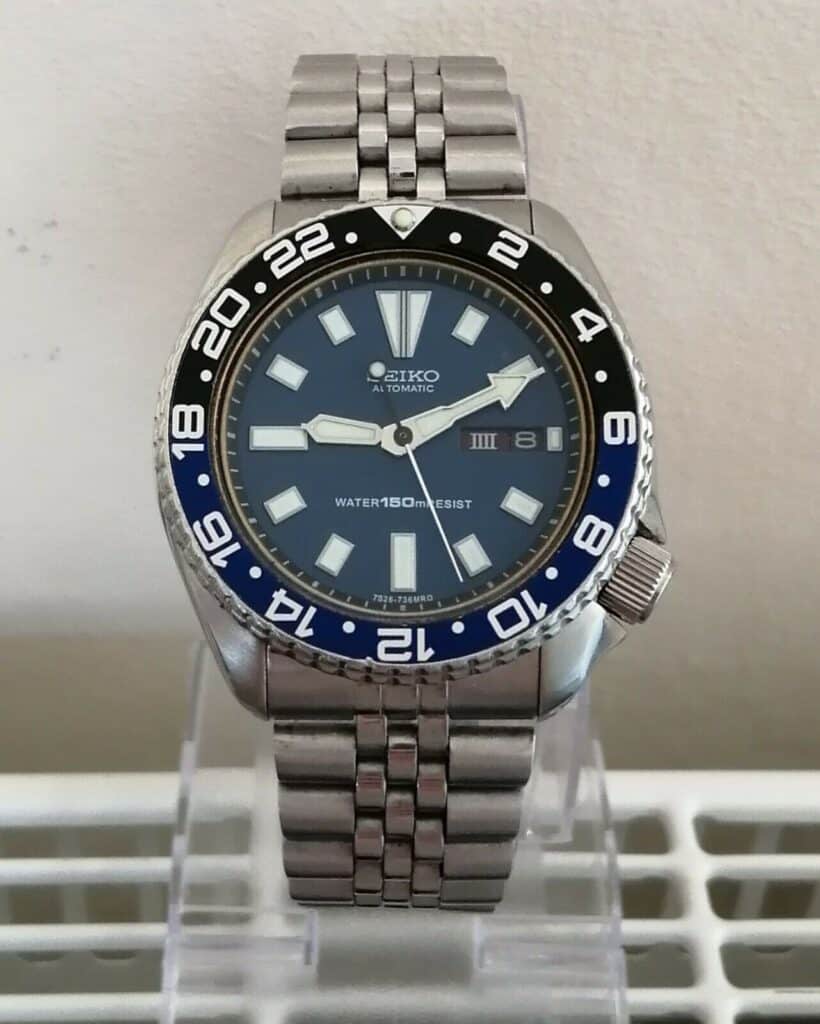While the chronograph and its tachymeter were initially designed for car racing drivers, dive watches like watches from Rolex, Seiko just to name a few because they have a unique story to their invention.
And regardless of whether you are a diver or not, you should know how a dive watch bezel works.
Trust us when we say you’ll be surprised at just how helpful dive watches can be in your everyday terrestrial life.
Dive watch bezel: Functionality and history
First introduced by Rolex and the Blancan in the 1950s, the rotating dive watch bezel has dramatically changed the watch industry with its impeccable performance as it was designed to track the time spent underwater by divers.
And because oxygen used by divers is limited, the bezel doubles as a reminder to prevent divers from going above their diving time limit.
Types of dive watch rotating bezel
Whether scaled or not, the rotating dive watch bezel is divided into 60 minutes or 12 hours.
Plus, most dive watch bezels come fitted with a luminescent zero marker in the form of a small triangle or circle.
That said, there are two types of dive watch bezels, and they include the bidirectional and unidirectional rotating bezel.
While the bidirectional rotating bezel came with most dive watches produced in the early 1950s, Blacain took things to a whole new level with the launch of the first unidirectional bezel fitted in their iconic Fifty Fathoms diver released in 1954
Because unidirectional bezels are designed to rotate counter-clockwise, they were considered a safer way to keep track of bottom time.
The cool thing about this type of bezel is that it works almost flawlessly.
For instance, if the bezel is accidentally moved underwater, instead of increasing the remaining dive time, it actually shortens it.
Understanding external and internal bezels
For those who are new to dive watches and looking to learn more about this remarkable timepiece, it will interest you to know that there are two types of dive watch bezels.
They include the famous external model and the internal model introduced afterward.
Just like its name, the external bezel is fitted on top of the watch.
On the flip side, the internal version is installed just under the watch glass.
The unique thing about the internal bezel is that it is operated by an additional crown.
Although the internal bezel is protected from unexpected movement by crystal, it is more challenging to manipulate than the external bezel, which comes with an indented grip.

Why luminescent markers are Needed
With traditional watches, the deeper you dive, the less visible things become.
But with dive watches, you have a brilliant watch that was designed to perform flawlessly underwater.
With their bezel lined with luminescent minute markers, this watch will remain visible as you descend.
Even dive watches that come with a single luminescent dot on their zero markers are able to perform flawlessly while being able to track time accurately.
Using a dive watch: What you should know
While dive watches have a remarkable design that will wow any watch lover, these types of watches come with many perks that will thrill you.
Besides being able to track time accurately, dive watches have some unique functionality you’ll love right from the get-go.
Read on as we bring you up to speed on how these brilliant timepieces work.
Using dive watches allows you to keep track of elapsed time.
Though this may sound a bit complicated, the operation and functionality are almost seamless.
To begin, all you have to do is wind the bezel to align the zero hand with the minute hand.
And as time elapses, the minute hand should continue to track as designed.
If the minute hand points to 20 on the bezel scale, it means that you have been diving for 20 minutes.
Sounds like a piece of cake, right?
Well, that’s because it is designed to be easy.
Keeping track of remaining time
Though you’ll need a bit of math here, it isn’t such a challenging one.
Say, for instance, a diver has only 25 minutes to stay under the water; the first thing you’ll need to do is subtract this number (25 minutes) from the 60 minutes to arrive at the remaining time.
So in our example, 60-20 will return 35.
Once you have figured that out, the next thing you want to do is wound the bezel to set the 35 mark scale on the bezel against the minute hand.
If you did this correctly, it would take exactly 25 minutes for the minute hand to get to the zero markers.
Even though you may not be a professional diver, this feature of the dive watch is something you want to get familiar with.
Without mincing words, the dive watch bezel will prove very handy if you’re interested in tracking elapsed or remaining time.
Besides helping to keep track of your bottom time, dive watch bezels can also be used to keep track of daily activities.
For people who prefer linguine al dente to soft mush, all you have to do is set your bezel to 8 minutes.
Also, if you like to indulge in a perfectly infused Cyan tea, you can time your dive watch for 3-4 minutes.
If you find yourself in a 30-minutes drop-off/pick-off only zones, your diver will ensure you don’t spend an extra minute.

Frequently asked questions
What is the purpose of the rotating bezel on a watch?
Most analog dive watches feature a rotating bezel that allows divers and professionals to read elapsed time easily.
This usually comes alive when tracking the length of a dive.
For many professionals, this is the feature that endeared them to the dive watch.
What is the purpose of a dive watch?
Thanks to dive watches, scuba divers and other professionals can know exactly how long they have been underwater.
Some models even come with a unique feature that allows wearers to keep track of their current depth.
Are dive watches expensive?
Like other types of watches, there are both affordable and expensive dive watches.
So depending on your budget, you’ll certainly find a dive watch that ticks all your boxes.
- Armand Nicolet JS9 Dive Watch Review
- Worthy Microbrand Dive Watches To Check Out
- Marina Militare Watch Review – Best Panerai Homage in 2024
- LIV GX1-A Signature Orange Watch Review – Guide 2024
- Omega Dive Watch Collection – Comparing in 2024
- Seiko 6139 Pogue Watch – A Deep Dive in 2024
- Seiko Giugiaro Watch – A Classic Deep Dive


